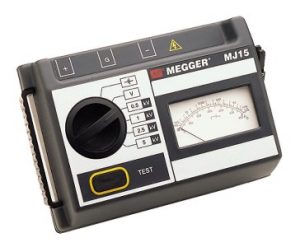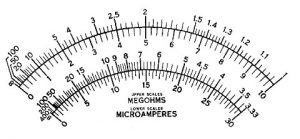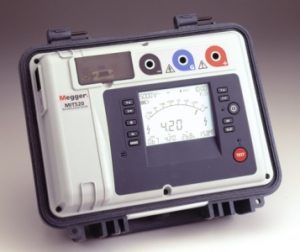The name Megaohm meter is classified further into the name Megger. This test is useful for the testing of internal cable resistance. This is one of the famous methods used for the testing of resistance and it was first introduced in 1903. This test is intended for use to detect the condition of the winding inside the instrument. By knowing the resistance value, we can opt for suitable safety precautions to be taken for the device in order not to get damaged. So, in this article, the detailed information regarding the performance of megger and different types that have been classified for the performance improvement has been discussed. In addition to these uses of this test, the working principle, operation procedure, types, and applications have also been discussed.
What is the Megger Test?
Megger is also called as a Megaohmmeter and is a device used for the testing of insulation resistance of a cable. Test performed so performed to know the insulation resistance value is known as Megger Test. A megger testing device is shown in the figure below.

Megger
What is the Use of Insulation Resistance?
The windings of the motor which are wound inside the motor must have provided some insulation resistance. This insulation is provided to oppose the heavy currents in the case of a short circuit. If the conductor is provided with high insulation, then higher will be its opposition of Electric current. Similarly, if the insulation resistance provided is weak, then there is more chance of flowing of heavy currents that damage the equipment. So, for the proper function of any device, it should have high insulation resistance. Therefore, for this reason, the megger insulation resistance test is done. The cable insulation is shown in the figure below.

Insulation
Working Principle of Megger
It works on the principle of electromagnetic attraction. When a current-carrying primary coil is placed under the influence of a magnetic field it experiences a force. This force produces a torque that is used to deflect the pointer of the device which gives some reading.
Procedure For Testing Insulation Resistance (IR)
The following steps are involved in the process of testing the IR value of the winding of a motor. The windings of the motor are classified as Red (R), blue (B), and Yellow (Y), and body (in the absence of neutral) or neutral (N). The following figure gives an idea of how the probes of a megger look like.

Megger
Step:1
Insert the measuring wires having probes, in the ports of Megger. It has two ports one is a Line and the other is a ground. Apart from these two, there is a push-button which acts as an insulation test. The figure below gives an idea of how IR testing by megger is conducted.

Megger Test Equipment
Step:2
Connect the probes of Megger one to the Line I,e (R) and the other to the ground. After connecting press the insulation test push button. Then, the megger should indicate infinite IR value, if there is no problem. If it indicates Zero, then we can come to the conclusion that the IR cannot withstand heavy currents.
Step:3
Repeat the process connecting the probes to the other Lines I,e (B) and then (Y). Check the value of IR value so that we can know whether the winding IR is good or not.
What if IR value is Infinite or Zero
When the probes of megger are connected to two different windings then if the IR value indicated is Infinite then the insulation resistance of the winding is sufficient to oppose the heavy currents. How the measuring reading of IR value in a megger is represented in the figure below.

Megohm Scale
But in the case of the IR value indicated is zero then we can understand that the winding is short-circuited. In short-circuit cases, the winding will not be in a situation to handle heavy currents because of low resistance and cannot oppose the heavy currents.
Types of Megger Test
There are two types of Megger. They are
- Hand Driven Type
- Electronic Type
Hand driven Type
Hand driven megger test consists of a handle that is used to drive a generator inside the Megger. This generator supplies DC power to the coil that is under the influence of a magnet. Due to the influence of the magnetic field, an emf is induced in the primary coil. The hand-driven megger is shown in the figure below.

Hand Driven Megger Test
There won’t be any deflection in the instrument until and unless the probes of the megger are connected to the windings. After the connection of the probes to the windings, the emf induced in the primary coil also induces emf in the secondary coil such that due to the principle of electromagnetic attraction deflection takes place in the megger.
Electronic Type
For the time being, electronic megger is introduced to overcome the disadvantages of the hand-driven type. It has a digital meter and a monitor that displays the exact values. The electronic type megger is shown in the figure below.

Electronic Type Megger Test
Human errors can be eliminated by electronic type compared with a hand-driven type. The working operation of electronic type is similar to that of a hand-driven type megger.
Precautions
- Never touch the probes while operating.
- Use only for high-resistance measurement.
- After knowing the IR value do not forget to switch off the supply.
Advantages
- Preventive repairs can be done after analyzing the IR value.
- Risk can be reduced.
- Life expectancy can be improved.
- Reliability can be increased.
- Easy to operate
- Easy to carry
- Highly accurate
- Cheaper
Disadvantages
- In a hand-driven type, the analog scale is used which is quite difficult to note readings compared to electronic type.
Applications
- Used in motors, transformers, and cables.
- Railways
- Power generation
- Quality Testing Companies
- Solar generation
- Industrial companies.
Thus, in this article, we had an overview of what is a megger test? and we conclude that it is a device that is used to test the insulation resistance of any equipment windings. Apart from this, we had also studied what is the use of this device? why insulation resistance is measured? procedure for finding IR value, types of megger instruments, advantages, disadvantages, and applications. Here is a question for the readers, what are the acceptable megger test values?